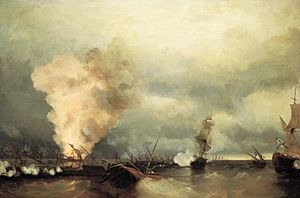Running the gauntlet of Vyborg
| date | July 2, 1790 to July 5, 1790 |
|---|---|
| place | Krysserort near Vyborg , Russia |
| output | Russia's tactical victory. Sweden's strategic victory |
| Parties to the conflict | |
|---|---|
| Commander | |
|
|
|
As Battle of Vyborg Bay ( Swedish Viborgska gatloppet ) is an operation of the Swedish archipelago fleet during the Russo-Swedish war signified the outbreak of the Bay of Vyborg on July 3, 1790th
prehistory
The Swedish King Gustav III. had defeated a Russian naval unit at Fredrikshamn on May 15, 1790 and was on his way east to attack the Russian fleet from Vyborg. Gustav's fleet was to meet with a second Swedish unit under Admiral Otto Henrik Nordenskjöld near Vyborg, which had recently escaped a Russian squadron near Reval . Nordenskjöld's association reached Vyborg Bay on June 2 and fought fruitless battles with the Russian units stationed there over the next two days. Then Nordenskjöld received the order to secure the escape route for Gustav's fleet.
On June 8, the Russian naval units of Vyborg and Reval had united, as did the units of Gustav III. and Nordenskjöld formed a common fleet. The Russian fleet, consisting of about 50 ships (liners and frigates ), positioned itself in a row in front of the large outlet of the bay. The Swedish side recorded about 250 ships with a crew of about 30,000. Gustav's association included B. 21 ships of the line , eight larger frigates, five smaller frigates and numerous supply boats.
Gustav III attempted an escape on June 17 with no significant result. Two days later the Russian fleet received reinforcements and threatened to attack. With the Swedish fleet cut off from its supply lines, it could not wait long to break out. It was decided to head west, but the headwind prevented this project for about ten days. The Russian Navy had a plan to encircle the Swedes with two fleets from Vyborg and from the fortress of Kronstadt .
The battle
On the night of July 2nd to 3rd, the Russian admiral Karl Heinrich von Nassau-Siegen and a unit from Kronstadt attacked a division of the Swedes from the south and forced them to retreat after 3½ hours of fighting. At about the same time, the Swedish Lieutenant Colonel Törning started a diversionary maneuver in the north.
On the morning of July 3, the wind was in the direction the Swedes wanted, and so one ship after another sailed through the first Russian line. They were fired at from two sides, but the losses were relatively small. The breakthrough was like running the gauntlet , which gave the battle its name. The second Russian line was broken without any significant difficulty, and Gustav III then sailed. in an open pinasse with a royal flag to the west. When he got within range of Russian ships, he changed vehicles and was able to safely join the Swedish ships ahead.
Most of the Swedish fleet had already passed the Russian line when a disaster occurred that resulted in greater losses. A Swedish Brander hit instead of the opponent's own two ships caught fire and exploded in the late morning. Three ships of the line and two frigates of the Swedes could no longer navigate through the smoke and ran aground. Only then did the Russian side decide to launch a massive counterattack. She pursued the ships that had already broken through and was able to destroy two of them. A Russian association with five ships had forced several Swedish boats to surrender elsewhere in the archipelago of Vyborg , but the higher order to pursue the Swedish main association released these boats again, so that they too, benefited by the upcoming storm, reached freedom.
When the Swedish fleet reached Sveaborg Fortress on July 5, their losses amounted to seven ships of the line, three frigates and a few smaller boats, and about 5,000 men.
literature
- Running the gauntlet of Vyborg . In: Theodor Westrin, Ruben Gustafsson Berg, Eugen Fahlstedt (eds.): Nordisk familjebok konversationslexikon och realencyklopedi . 2nd Edition. tape 32 : Werth – Väderkvarn . Nordisk familjeboks förlag, Stockholm 1921, Sp. 214 (Swedish, runeberg.org ).
